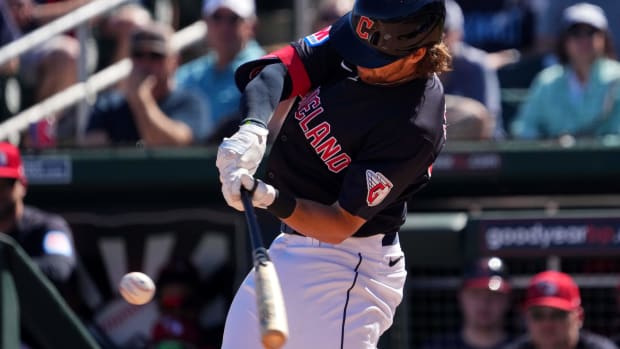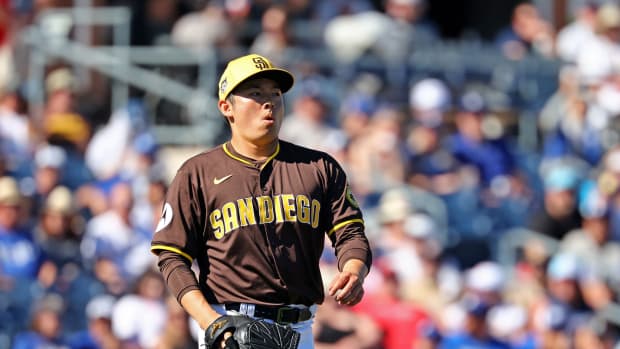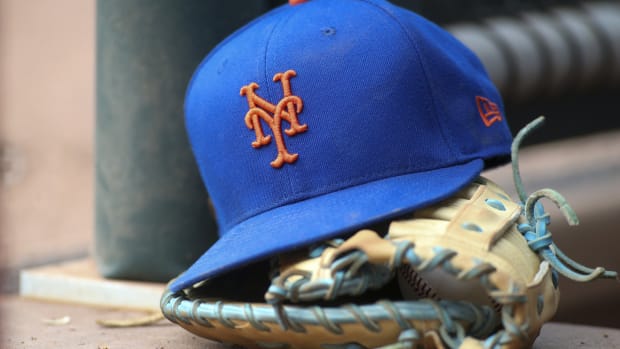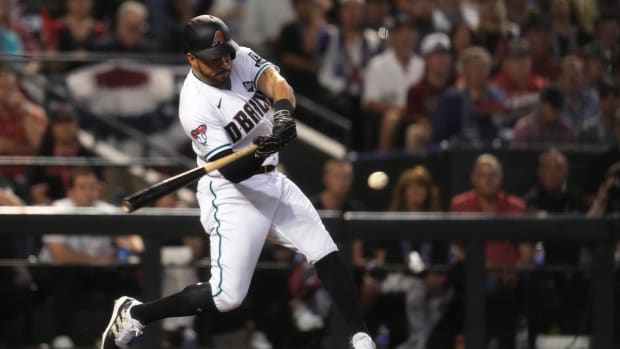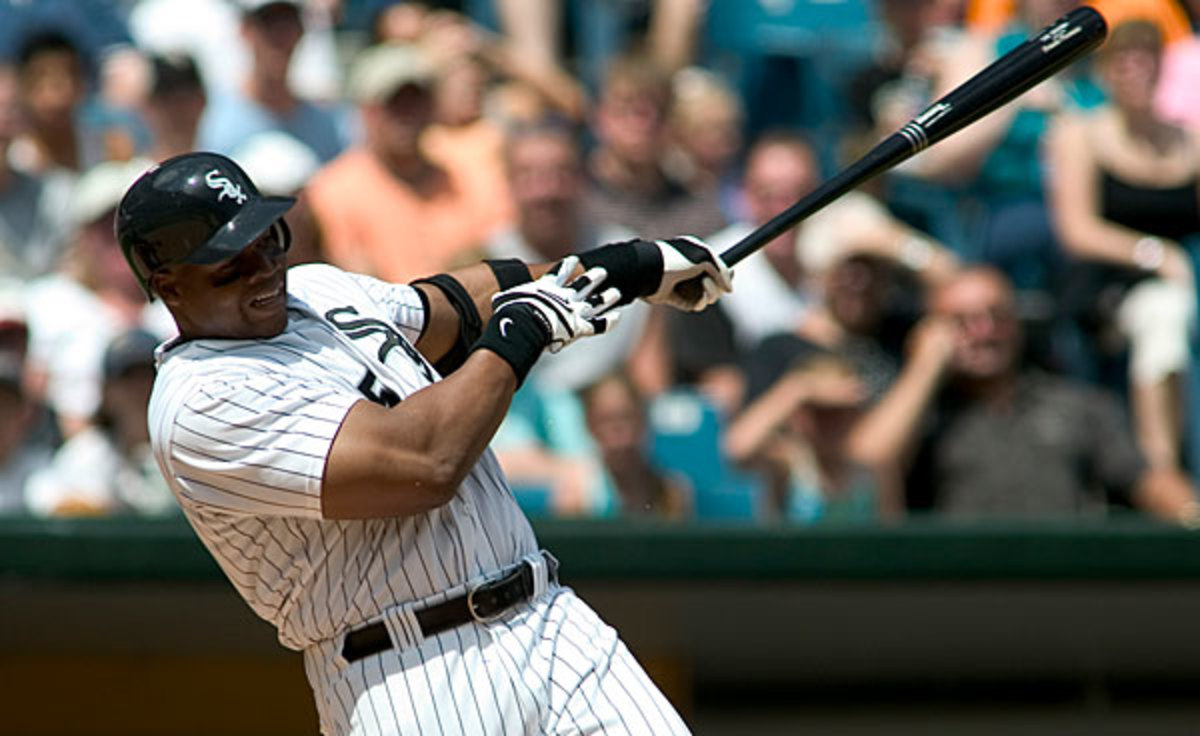
JAWS and the 2014 Hall of Fame ballot: 14 thoughts on the voting results
Frank Thomas hit 521 home runs and easily gained election to the Hall of Fame in his first year of eligibility. (Chuck Rydlewski/Icon SMI)
The following article is part of my ongoing look at the candidates on the BBWAA 2014 Hall of Fame ballot. For a detailed introduction to JAWS, please see here. For the breakdowns of each candidate and to read the previous articles in the series, see here.
The results are in. On Wednesday afternoon, the BBWAA announced that for the first time since 1999, its voters have elected three players to the Hall of Fame in a single year. Receiving the necessary 75 percent of the vote were Greg Maddux (97.2 percent), Tom Glavine (91.9) and Frank Thomas (83.7), all in their first year of eligibility. Just missing the cut was second-year candidate Craig Biggio, who got 74.8 percent, falling two votes shy of election.
Biggio aside, it's a bumper crop of well-qualified candidates with strong credentials on both traditional and sabermetric merits. Maddux and Glavine each won more 300 wins and combined for six NL Cy Young Awards, while Thomas hit 521 home runs and won a pair of AL MVP awards. All three clear the JAWS standard at their position by a wide margin, which is to say that they're above-average with respect to the already-enshrined players at their position.
In all, the trio of elected players is a dramatic contrast to last year's results, when for the first time since 1996, nobody on the ballot received enough votes to gain entry. Biggio topped the 2013 field with 68.2 percent.
The three players elected matches the total in the previous three cycles. Prior to the 2013 shutout, Bert Blyleven and Roberto Alomar were elected in 2011 and Barry Larkin in 2012. The trio of honorees joins the 1999 class (George Brett, Nolan Ryan and Robin Yount) as the only ones of the past 50 years to include three first-ballot Hall of Famers. The last time a player went in on the first try was in 2009, when Rickey Henderson gained entry. The last time multiple first-year candidates went in was in 2007, when Tony Gwynn and Cal Ripken both sailed in with more than 97 percent of the vote.
There's a whole lot more to unpack within these results, so let's go to the bullet points: 14 more thoughts on the 2014 Hall of Fame ballot.
1. Maddux did not receive unanimous support, in keeping with the grand tradition of idiocy that prevented superstars such as Babe Ruth, Willie Mays and Hank Aaron from unanimity as well. His 97.2 percent is the eighth-highest share of the vote in history; Tom Seaver (98.84 percent in 1992) holds the record.
2. Maddux and Glavine are first teammates to be elected by the BBWAA since Mickey Mantle and Whitey Ford were elected in 1974; in that case, Mantle was on his first ballot but Ford was in his second year. The two mainstays of the Braves' staff will join manager Bobby Cox at the induction ceremonies in Cooperstown on July 27. Cox was elected along with fellow managers Tony La Russa and Joe Torre via the Expansion Era committee vote in December.
3. Thomas is the first slugger with at least 500 homers to be elected to the Hall of Fame since Eddie Murray in 2003. Since Murray hit his 500th homer in 1996, 10 players have reached that milestone, five of whom were on this year's ballot (more about the others below). Thomas is also the first player to be elected who spent the majority of his career — 57 percent in terms of plate appearances — as a designated hitter, though he was primarily a first baseman when he won back-to-back AL MVP awards in 1993 and '94.
4. In his 15th and final year of BBWAA eligibility, Jack Morris fell far short of election. After receiving 67.7 percent of the vote in 2013, he got just 61.5 percent this time around. The combination of two strong first-year classes in a row and something of a makeup vote from last year's shutout prevented him from the type of gains that sent other recent honorees who were elected late in the process — such as Jim Rice (2009, 15th try) and Bert Blylelven (2011, 14th) — over the top. Gil Hodges remains the only candidate to receive at least 50 percent and not gain entry via either the BBWAA or the Veterans Committee, though Morris now threatens to join him. He will next be eligible on the 2017 Expansion Era committee ballot assuming the process stays the same between now and then.
5. In missing by two votes, Biggio tied a dubious record for having the closest margin by which any player has fallen short via the writers' ballot. It's the second straight year Biggio has been a part of history for the wrong reasons. Last year, he joined Rafael Palmeiro are the only two modern players with at least 3,000 hits who weren't voted in during their first year of eligibility.
That distinction is far more understandable in the case of Palmeiro given that he was the game's first star to be suspended for testing positive for performance-enhancing drug use. Biggio has no such mark against his name; he never failed a test, and his name has never turned up in the Mitchell Report or any other investigation. Nevertheless, his candidacy has been hurt both by unsubstantiated rumors that he may have used and by a small group of voters who refuse to consider anybody from the so-called "Steroid Era." In fact, had Ken Gurnick's Jack Morris-only ballot and that one lone blank ballot not come in, Biggio would have had his 75 percent.
6. As close as Biggio came, missing by less than 10 votes isn't unprecedented even in recent history. In 2010, Blyleven missed by five votes and Roberto Alomar by eight; both were elected the next year. In terms of overall margin, Pie Traynor missed by two votes in 1947 and was elected by the writers the following year, while Nellie Fox fell two votes shy in his final year on the ballot (1985) and he — or rather his descendants and anyone else who cared, since he had passed away — had to wait until 1997, when the Veterans Committee voted him in.
With Randy Johnson, Pedro Martinez, John Smoltz and Gary Sheffield eligible for the first time next year, Biggio won't have an easy time of picking up new votes so long as the 10-candidate per ballot rule stays in place, but gaining two shouldn't be impossible.
7. Despite the near miss, Biggio was one of only two holdover candidates to gain ground relative to last year. Mike Piazza, who received 57.8 percent of the vote in 2013, climbed to 62.2 percent, suggesting he's well on his way to eventual entry even if it's taking longer than expected.
8. Third-year candidate Jeff Bagwell was the only other candidate who received at least 50 percent of the vote this year, though he lost ground, falling from 59.6 percent in 2013 to 54.3 percent this time around. Tim Raines, who topped 50 percent for the first time last year by receiving 52.2 percent, fell back to 46.1 percent in this, his seventh year of eligibility. Lee Smith, who got 50.6 percent in 2012 (his 10th year of eligibility), lost even more ground than he did last year, when he fell to 47.8 percent; this time he plummeted to 29.9 percent and now has just three years of eligibility left.
9. Barry Bonds and Roger Clemens both lost ground. Despite overwhelming resumes and shelves full of awards, the pair continues to be dragged down by their connections to performance-enhancing drugs. Bonds fell from 36.2 percent in his 2013 debut to 34.7 percent, and Clemens dropped from 37.6 percent to 35.4 percent. Not that it was a surprise; even voters willing to consider them despite their PED connections had little trouble nudging them aside to cope with the tremendous array of candidates. The pair have long roads ahead to election, and it certainly won't happen in 2015.
10. Mike Mussina and Jeff Kent both received double-digit support despite former Hall of Fame researcher Bill Deane's mid-December forecast of single-digit percentages. The Moose got 20.3 percent of the vote, Kent 15.2 percent. Since the return of annual balloting in 1966, Duke Snider (17.0 percent) and Blyleven (17.5 percent) have the lowest debut showings of any candidates to gain eventual entry via the BBWAA, and several received less than that and went in via the VC.
11. Palmeiro fell off the ballot after receiving just 4.4 percent of the vote. Despite being one of only four players in history with at least 3,000 hits and 500 homers, Palmeiro's 2005 suspension for a positive PED test made him an easy target to be skipped. Under current Hall of Fame rules, he won't be eligible again until 21 years after his final major league season, which means for the 2026 ballot, via whatever VC-type process is in place by then. Meanwhile, Mark McGwire (11.0 percent) and Sammy Sosa (7.2 percent) both lost about five percent and are probably headed toward that fate in a year or two.
12. Palmeiro was the only holdover candidate to fall off due to the five percent rule, but plenty of first-year candidates won't be back: Moises Alou, Armando Benitez, Sean Casey, Ray Durham, Eric Gagne, Luis Gonzalez, Jacque Jones, Todd Jones, Paul Lo Duca, Hideo Nomo, Kenny Rogers, Richie Sexson, J.T. Snow and Mike Timlin each received six or fewer votes.
13. It was a rough year for other popular holdover candidates, particularly those whose credentials are perceived to be stronger on the sabermetric front than the traditional one. Curt Schilling (29.2 percent in his second year of eligibility), Edgar Martinez (25.2 percent in his fifth year), Alan Trammell (20.8 percent in his 13th year) and Fred McGriff (11.7 percent in his fourth year) each lost at least nine percent relative to 2013. Martinez, Schilling and Trammell all clear the JAWS bars at their position.
14. In all, there were 571 ballots cast, two more than in 2013 but two fewer than in 2012, and 10 fewer than in 2011, which still holds the record. The ballots included an average of 8.39 names, the highest total since 1960, when it was 8.6. That mark came when the BBWAA was voting on a biennial basis; the writers returned to voting annually in 1966. A whopping 50 percent of the voters used all 10 slots, up from 22 percent last year — a figure that points towards the organization recommending that the Hall of Fame change its rules to allow for more votes per ballot. There was only one blank ballot this year, compared to five a year ago.
I'll be back tomorrow with a look at next year's ballot and the future of the BBWAA vote. In the meantime, I'd like to extend thanks to so many — far too many to name — who have said positive things about my work on the Hall of Fame front and turned this space into a go-to spot during election season.































